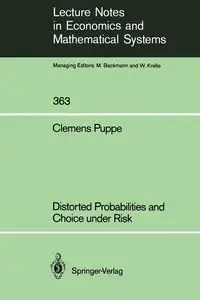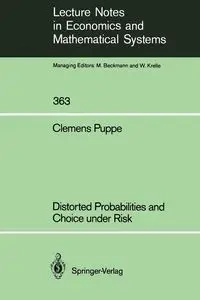Distorted Probabilities and Choice under Risk - Puppe Clemens
Distorted Probabilities and Choice under Risk - Puppe Clemens
AutorzyPuppe Clemens
EAN: 9783540542476
Marka
Symbol
775HIY03527KS
Rok wydania
1991
Strony
116
Oprawa
Miekka
Format
15.6x23.4cm
Język
angielski

Bez ryzyka
14 dni na łatwy zwrot

Szeroki asortyment
ponad milion pozycji

Niskie ceny i rabaty
nawet do 50% każdego dnia
Niepotwierdzona zakupem
Ocena: /5
Marka
Symbol
775HIY03527KS
Kod producenta
9783540542476
Rok wydania
1991
Strony
116
Oprawa
Miekka
Format
15.6x23.4cm
Język
angielski
Autorzy
Puppe Clemens

During the development of modern probability theory in the 17th cen tury it was commonly held that the attractiveness of a gamble offering the payoffs :1:17 ••• ,:l: with probabilities Pl, . . . , Pn is given by its
expected n value L:~ :l:iPi. Accordingly, the decision problem of choosing among different such gambles - which will be called prospects or lotteries in the sequel-was thought to be solved by maximizing the corresponding
expected values. The famous St. Petersburg paradox posed by Nicholas Bernoulli in 1728, however, conclusively demonstrated the fact that individuals l consider more than just the expected value. The resolution of the St.
Petersburg paradox was proposed independently by Gabriel Cramer and Nicholas's cousin Daniel Bernoulli [BERNOULLI 1738/1954]. Their argument was that in a gamble with payoffs :l:i the decisive factors are not the payoffs
themselves but their subjective values u( :l:i)' According to this argument gambles are evaluated on the basis of the expression L:~ U(Xi)pi. This hypothesis -with a somewhat different interpretation of the function u - has
been given a solid axiomatic foundation in 1944 by v. Neumann and Morgenstern and is now known as the expected utility hypothesis. The resulting model has served for a long time as the preeminent theory of choice under risk,
especially in its economic applications.
EAN: 9783540542476
EAN: 9783540542476
Niepotwierdzona zakupem
Ocena: /5
Zapytaj o produkt
Niepotwierdzona zakupem
Ocena: /5
Napisz swoją opinię

